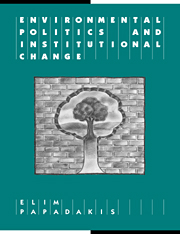Book contents
- Frontmatter
- Contents
- List of Tables and Figures
- Preface and acknowledgements
- Abbreviations
- Part I Introduction
- Part II Political Institutions, Innovation and Social Change
- Part III Political Organisations and Adaptation
- 8 Inertia and innovation
- 9 Missed opportunities: The Liberal and National Parties
- 10 Leading the charge for the green vote: The Australian Labor Party
- 11 Fundamentally green: The Australian Democrats
- 12 Overcoming institutional inertia
- Part IV The Media, Agenda Setting and Public Opinion
- Part V Conclusion
- Appendix: Codes used in tables 9.1 to 12.1
- Notes
- References
- Index
11 - Fundamentally green: The Australian Democrats
Published online by Cambridge University Press: 18 December 2009
- Frontmatter
- Contents
- List of Tables and Figures
- Preface and acknowledgements
- Abbreviations
- Part I Introduction
- Part II Political Institutions, Innovation and Social Change
- Part III Political Organisations and Adaptation
- 8 Inertia and innovation
- 9 Missed opportunities: The Liberal and National Parties
- 10 Leading the charge for the green vote: The Australian Labor Party
- 11 Fundamentally green: The Australian Democrats
- 12 Overcoming institutional inertia
- Part IV The Media, Agenda Setting and Public Opinion
- Part V Conclusion
- Appendix: Codes used in tables 9.1 to 12.1
- Notes
- References
- Index
Summary
The Australian Democrats were founded in May 1977. The former Australia Party and the South Australian Liberal Movement played an important part in their formation. Their first leader, Don Chipp, had been a minister in the federal Liberal government. His leadership was crucial to the success of the new party: ‘Chipp presented a quixotic figure and pledged, in characteristically earthy language, to “keep the bastards honest”. Although … the policies of the Australian Democrats should not be discounted, the initial appeal of the party seemed to owe more to Chipp's ability to tap idealism and disenchantment than to rational commitment to Democrat policies’ (Shamsullah 1990: 167).
The Australian Democrats are a national party with ancillary state divisions. The National Executive comprises the president, two deputy presidents, the leader and deputy leader of the party in the Senate, and two representatives from each division. All these officers are elected by a ballot of party members. In addition to the emphasis on participatory democracy, the Democrats insist on involvement by party members in deciding on policy guidelines.
Policy proposals, formulated by various committees, are published in the official journal. They become party policy only if supported by a majority of members: ‘Policies shall be formulated with the maximum participation of members and shall finally be determined by the direct and equal say of the membership by a voluntary postal vote’ (Australian Democrats National Constitution July 1978: 3; and July 1993: 5). Thus policy-making is a continuous process.
- Type
- Chapter
- Information
- Environmental Politics and Institutional Change , pp. 119 - 129Publisher: Cambridge University PressPrint publication year: 1996



